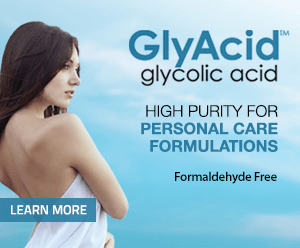Improving Dull Skin Tone with Glycolic Acid
February 16, 2021

“The ingredient can tackle hyperpigmentation, dullness, and signs of skin aging, such as lines and wrinkles, without breaking a sweat,'” Deanna Pai writes in Glamour. “Glycolic acid is the workhorse of exfoliating acids.”
For help combatting dull, uneven skin tone, glycolic acid is the perfect ingredient to quickly shed off dead, dry skin, improve cell turnover, and support hyaluronic acid production.
What causes dull skin tone?
Dull skin can be caused by a wide variety of factors. To start, stress and environmental factors like pollution can wreak havoc on the skin. Dryness and irritation can also diminish glow, as well as intense temperatures.
But, perhaps the most common factor behind dull tone is a lack of skin cell turnover.
“There are many factors that contribute to dull skin. A major contributor is poor cell turnover, which worsens with age. As we age, our skin cells produce less oil and don’t retain as much moisture. This results in an accumulation of dead skin cells, which makes your skin look dull,” dermatologist Joyce Imahiyerobo-Ip, MD, FAAD, told WhoWhatWear. “Even youthful skin can appear dull if it’s dehydrated and not properly moisturized.”
Luckily for consumers, there is a simple, effective skincare ingredient to combat dull skin and increase skin cell turnover. Glycolic acid, the “holy grail of exfoliation.”
Sloughing away dull skin
To begin, glycolic acid is a top choice for improving dull skin tone because glycolic acid is one of the most effective, fast-acting chemical exfoliators available.
When skin cells build up on the surface of the face, the skin appears dull, discolored, and dehydrated. Another unfortunate side effect? Dull, poorly moisturized skin often highlights signs of aging like fine lines and discoloration.
However, glycolic acid can offer quick relief.
Glycolic acid quickly revives dull skin
Glycolic acid is ace at quickly shedding off dead skin cells because it has the smallest size and the lightest molecule weight of the Alpha Hydroxy Acid family.
Once glycolic acid is topically applied to the skin, it works to loosen the bonds holding older skin cells together. This helps to slough away dull, dry skin cells and to rapidly improve radiance and glow.
“Glycolic acid increases luminosity of the skin because it exfoliates the outermost dead layer of the skin, the Stratum Corneum, and improves the reflection of light on the skin. Sometimes people use scrubs, which are abrasive and can cause irritation, but unlike scrubs, when glycolic acid is used at the right percentage and when done appropriately, it’s a much gentler way to exfoliate the skin,” Dr. Carmen Castilla, Tribeca Skin Center, told Elle.
By shedding off dead cells from the surface, glycolic acid helps to pave the path for fresher, newer cells to make their way to the top of the skin.
A hyaluronic acid booster
Another key reason glycolic acid is so effective at reviving dull skin tone is because it is a helpful partner to hyaluronic acid.
Hyaluronic acid is a humectant that occurs naturally within the skin and is important for promoting a healthy, hydrated complexion and glowing skin tone.
Hyaluronic acid works to improves skin tone by trapping water to collagen, the protein responsible for keeping skin firm and plump looking.
“As a topical product, as long as it is in the right formulation, hyaluronic acid will make the skin appear more dewy and younger because it improves skin elasticity,” Dr. Kavita Mariwalla, dermatologist, told Harper’s Bazaar.
Scientific research has also determined that glycolic acid can help boost the production of hyaluronic acid, improving skin plumpness and glow.
“Epidermal and dermal hyaluronic acid and collagen gene expression were all increased in glycolic acid-treated skin as compared to vehicle-treated controls. Conclusion: Our data suggest that epidermal and dermal remodeling of the extracellular matrix results from glycolic acid treatment. Longer treatment intervals may result in collagen deposition as suggested by the measured increase in mRNA,” Glycolic Acid Treatment Increases Type I Collagen mRNA and Hyaluronic Acid Content of Human Skin, Dermatologic Study.
Glowing up
Most consumers today want a radiant complexion and glowing skin tone. Regular use of superstar exfoliator glycolic acid can help slough away dull, dead skin, improve cell turnover, and boost hyaluronic acid production.
For consumers ready to banish dull skin tone, glycolic acid is the perfect ingredient to deliver fast, visible results.







